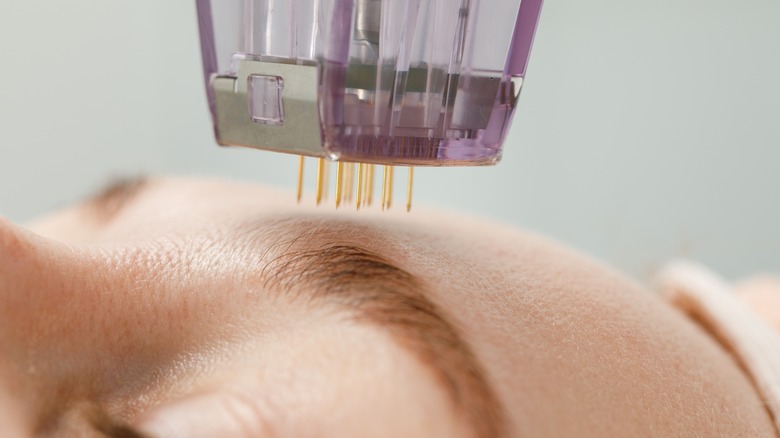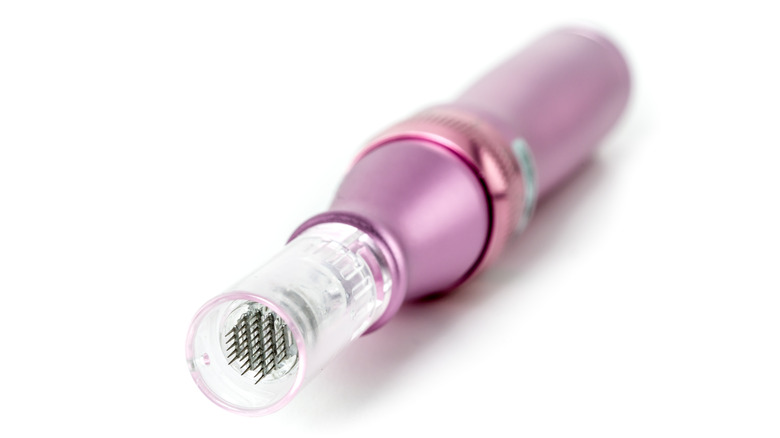Derma Stamping Is The Derma Rolling Alternative Sensitive Skin Needs
We may receive a commission on purchases made from links.
Derma rolling is one of the most effective age-diminishing treatments that you can do at home. It is a process that uses microneedles to make micro-punctures in the skin to stimulate collagen production. As a result, derma rolling corrects discoloration, treats wrinkles, improves skin texture, and even reduces sebum production. What's more? A 2018 study published in the Indian Journal of Dermatology found it effective in fading acne scars.
The downside is that you need to roll the device pretty hard to maximize your derma rolling benefits, which can cause some injuries and irritation. Luckily, the itchiness, bleeding, and redness clears up in a few days and are easy to forget because of the visible results. Except if you have sensitive skin.
Since this skin type gets irritated easily, the intense dragging that derma rolling requires often causes breakouts and inflammation that last for painfully long periods. If you've given up on derma rolling for this reason, we've got news: derma stamping is the derma rolling alternative your skin needs.
Derma stamping requires less movement than derma rolling
Derma stamps work like regular stamps, but they have a micro-needle cartridge instead of a stamping plate. This eliminates the need for rolling, making it a better choice for sensitive skin. Derma stamps also allow you to work on small areas at a time, so it's easier to treat or avoid specific extra-sensitive spots. These two factors lower the chances of skin irritation.
Using a derma stamp is easy; place it on the part of your skin you want to treat and press down to drive the microneedles in. Don't worry, it's not as painful as it sounds, plus derma stamping is less painful than derma rolling for many people. However, if the needles scare you, consider purchasing an adjustable derma stamp. That way, you can set the needles to smaller lengths of 1.5 to 2.5 mm and make the process entirely painless (the Dr. Pen Adjustable Microneedling Derma Stamp offers this kind of adjustability). Starting with smaller needles is okay, but deeper skin penetration equals more visible results.
Derma stamping is also more hygienic than derma rolling, which is a massive plus if skin sensitivity is an issue for you. The needles in derma rollers are arranged in rows on the wheel, making cleaning tricky. With derma stamps, however, cleaning isn't required since the cartridges are replaceable.
Derma stamping can be drying for sensitive skin
Derma stamps are used more strategically than derma rollers, making them more effective. However, this also means you should expect increased skin dryness. This is great for oily, sensitive skin, but it can be hellish for other sensitive skin types.
One way to get around this is by loading your after-care routine with moisturizing ingredients like hyaluronic acid. Hyaluronic acid serums for sensitive skin moisturize and soothe your dermis, making up for reduced sebum production. You should also consider using your chosen serum as you stamp your face.
Finally, it would help if you avoided harsh products during and after derma stamping. Micro-punctures make your skin more absorbent, so drying ingredients like retinol — or worse — salicylic acid, could have harsher effects than usual. Remember that stinging or burning sensations are signs that your skincare is doing more harm than good. Using silk pillowcases while you sleep is also a great idea, so your skin isn't tugged at or irritated while it heals.


